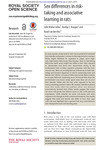Sex differences in risk-taking and associative learning in rats
| dc.contributor.author | Jolles, Jolle Wolter | en_US |
| dc.contributor.author | Boogert, Neeltje J. | en_US |
| dc.contributor.author | Bos, Ruud Van Den | en_US |
| dc.date.accessioned | 2016-10-11T05:37:13Z | |
| dc.date.available | 2016-10-11T05:37:13Z | |
| dc.date.issued | 2015 | en_US |
| dc.identifier.other | HPU4160661 | en_US |
| dc.identifier.uri | https://lib.hpu.edu.vn/handle/123456789/23551 | en_US |
| dc.description.abstract | In many species, males tend to have lower parental investment than females and greater variance in their reproductive success. Males might therefore be expected to adopt more high-risk, high-return behaviours than females. Next to risk-taking behaviour itself, sexes might also differ in how they respond to information and learn new associations owing to the fundamental link of these cognitive processes with the risk– reward axis. Here we investigated sex differences in both risk-taking and learned responses to risk by measuring male and female rats’ (Rattus norvegicus) behaviour across three contexts in an open field test containing cover. We found that when the environment was novel, males spent more time out of cover than females. | en_US |
| dc.format.extent | 10 p. | en_US |
| dc.format.mimetype | application/pdf | en_US |
| dc.language.iso | en | en_US |
| dc.subject | Psychology and cognitive neuroscience | en_US |
| dc.subject | Behaviour | en_US |
| dc.subject | Ecology | en_US |
| dc.subject | Cognition | en_US |
| dc.subject | Conditioning | en_US |
| dc.subject | Exploratory behaviour | en_US |
| dc.subject | Learning | en_US |
| dc.subject | Rats | en_US |
| dc.title | Sex differences in risk-taking and associative learning in rats | en_US |
| dc.type | Article | en_US |
| dc.size | 512KB | en_US |
| dc.department | Education | en_US |
Files in this item
This item appears in the following Collection(s)
-
Education [806]

